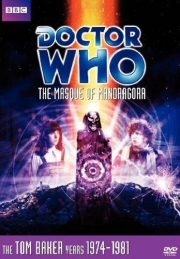Masque of Mandragora
- Sci-Fi
- 1976
- Buy the DVD
Reviewed by Ross Ruediger
()
The classic range of “Doctor Who” DVDs is in a weird area right now. Much of the good stuff has already been released, and so plenty of the mediocre material is currently making its way to the silver platter. There’s still a number of great stories that have yet to see the light of day, but since the goal is to finally get all of it out there and available within the next three or so years, the great ones are becoming fewer and farther between. The idea is to keep people interested in the range by not just releasing all the good stuff at once, and having some duff stories left over at the end that few will care about. “The Masque of Mandragora” is unquestionably one of the great ones, and an essential add to any serious “Who” DVD collection.
It begins with the Doctor (Tom Baker) and Sarah Jane (Elisabeth Sladen) wandering around the TARDIS corridors, engaging in delightfully witty banter. They come across the secondary console room, which is designed much darker and more intimate than the usual one; it’s covered with wood panels and has a considerably smaller console in the center. Before long, the ship lands, and they find themselves in a whacked-out void covered in giant crystals known as the Mandragora Helix. A ball of Helix energy attacks and they hightail it out of there, but little do they know, the energy has hitched a ride.
And so the TARDIS takes them away to 15th Century Italy, where the Doctor and Sarah find themselves caught up in a power struggle between Count Federico (Jon Laurimore) and his idealistic nephew, Giuliano (Gareth Armstrong). The Count desires the throne that rightfully belongs to Giuliano, and he uses the court astrologer, Hieronymous (Norman Jones), to make bogus predictions about the young man’s impending death. Of course, once the predictions are made, the Count will do whatever it takes to off the boy. And the Cult of Demnos, a centuries-old sect, long since thought to have died out, is on the move again. Enter the Helix energy, which begins using Hieronymous to do its bidding. He quite understandably thinks a god is speaking to him, and it is, which is admittedly odd because one wouldn’t think a ball of energy could talk. We don’t learn much about the Helix within the story, and a great deal of what the concept’s all about is left up for the viewer to ponder.
There are many great aspects to “The Masque of Mandragora,” but for this viewer, the divide between superstition and free thought is at the forefront. This is an angle that, when done properly on “Doctor Who,” is one of my favorite aspects of the series. The Count represents the struggle for power, while Guiliano symbolizes strength through thought and reason, and Hieronymous subs for the pitfalls of superstition and religion. It’s a wonderful setup that leads to a complex series of double-crosses, backstabs and sly commentary throughout. It never gets in the least bit preachy in that regard, but for those who want to see it, it’s there. Adding to the thoughtful, slick script by Louis Marks is some incredible set design and a fresh location shoot at Portmeirion in Wales – the same place “The Prisoner” was shot. The team’s real good at masking the more modern-looking aspects of the village, but you can still see Number 2’s green dome in at least one shot. Further, since the only monster in the story is a ball of energy, there are no rubber creatures to potentially queer the goings-on.
Speaking of queer goings-on, it behooves me to mention the relationship between Guiliano and his “companion” Marco (Tim Pigott-Smith, who would go on to someday play Mr. Creedy in “V for Vendetta”). Yes, these guys seem like a gay couple living in the 15th century, but I do not think that they are. There’s just enough evidence to the contrary in the story, but it’s also possible that evidence is a writer’s beard of some sort. As with the pro-secular undertones, if you want to see it, then yeah, these two guys are most definitely having a gay old time in San Martino. It’s interesting to note that aside from the Doctor and Sarah, they’re also the only two decent, good people in the story. The Cult of Demnos isn’t quite as creepy as it should be, but when they’re still and silent there’s something malevolent about them. They dress identical to and are frequently shot like the masked partiers in “Eyes Wide Shut,” enough so that I’d swear Kubrick caught this in ’76, and the imagery stuck with him all those years. It’s also got some charming action bits – the Doctor rides horses in a couple scenes, gets into a swordfight in another, and in one scene does a kick flip to someone’s chin. And Sarah, alas poor Sarah, is reduced to being nearly sacrificed on two occasions and hypnotized on another. More often than not she’s little more than a damsel in distress for the Doctor to rescue. It’s funny how different Sarah Jane is at this point compared to the way the character was originally envisioned – as a staunch, outspoken feminist. Not so here, but she does exactly what she’s called upon to do, and I dare say that nobody does it as well as Lis Sladen.
I could probably go on for another 500 words about the kitschy coolness of this story, but I’ll close with the idea that if American fans have been lifelong devotees of this show, “The Masque of Mandragora” is probably a big reason why.
Special Features: There’s a nice, efficient commentary track with Tom Baker, producer Philip Hinchcliffe, Gareth Armstrong and production unit manager Chris Doyly-John. “The Secret of the Labyrinth” is a great little making-of. “Bigger on the Inside” is a feature about the changing look of the TARDIS interior. “Now and Then” is a location piece based around Portmeirion. “Beneath the Masque” is an insanely funny comedy sketch by Gareth Roberts and Clayton Hickman. As I understand it, this was something of controversial extra amongst fandom when the disc came out some time ago in the U.K., but the controversy largely seemed to boil down to whether or not one found it funny. I did. Laughed lots. Would watch more! Of course, there’s also the usual photo gallery, production notes option, and DVD-Rom materials.
You can follow us on Twitter and Facebook for content updates. Also, sign up for our email list for weekly updates and check us out on Google+ as well.













